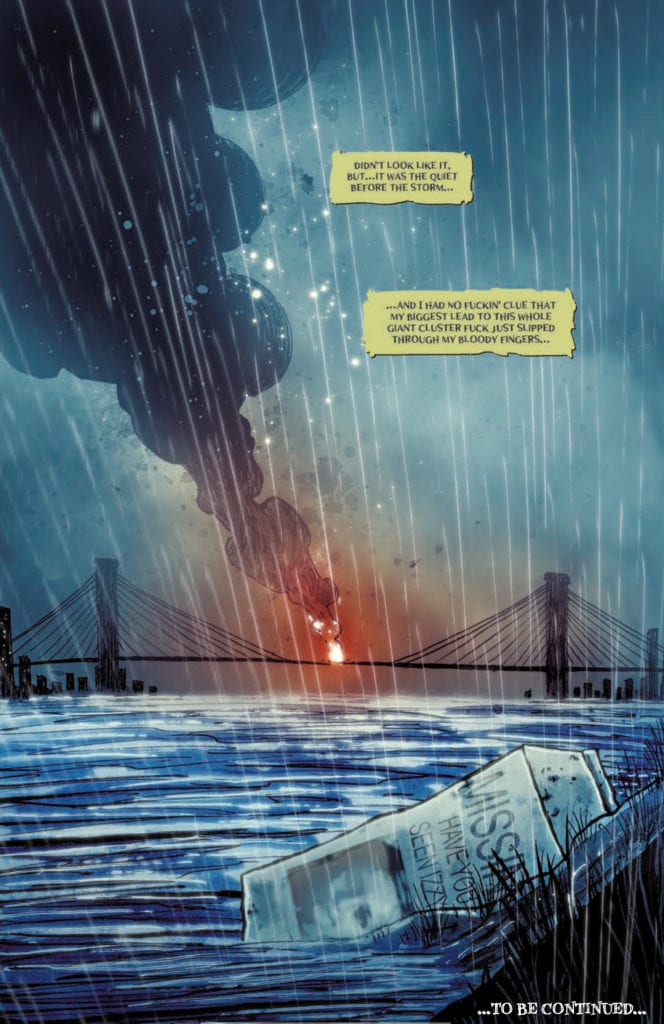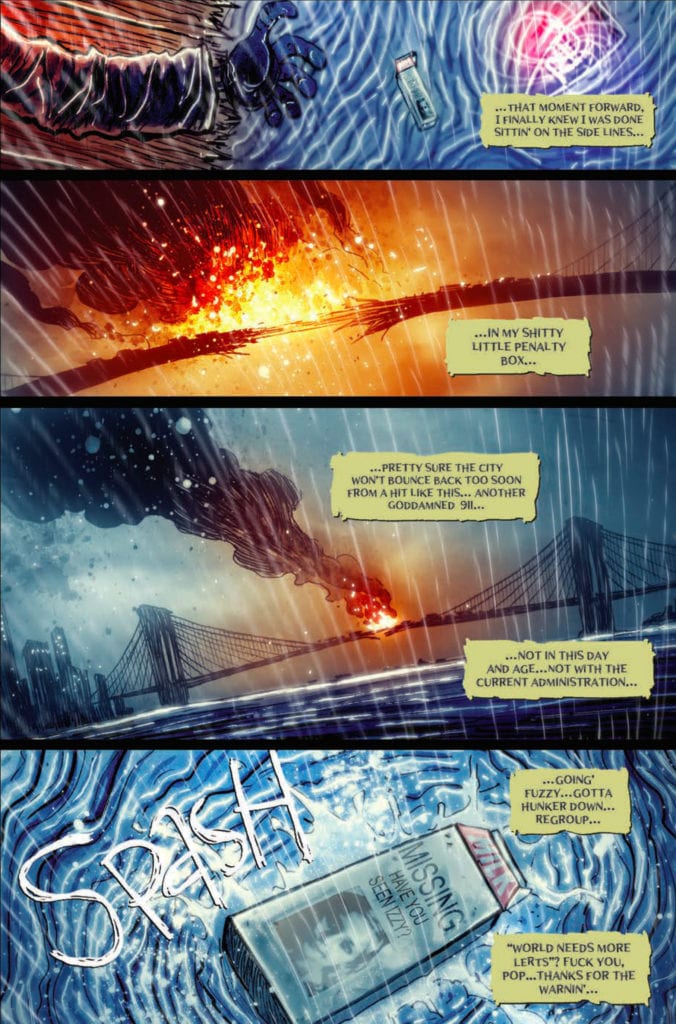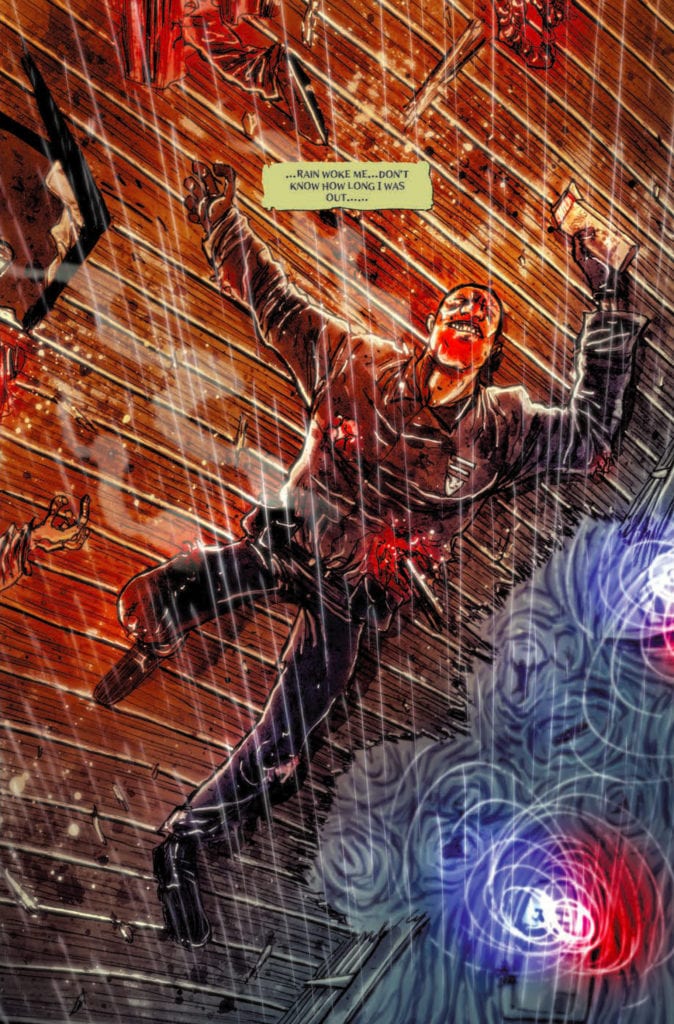From writers Dan Fogler and Laurence Blum and artist Ben Templesmith comes a bleak, brutal, and madness-filled look at a NYC militarized disaster zone through the lens of a slightly insane, somewhat addled detective in Fishkill Vol. 1 from Heavy Metal publishing. This over-the-top neo-noir is an assault on the senses, grabbing the reader by the shirt collar and dragging them along in a manner that evokes Miller’s Sin City and the best 2000 A.D. Dredd stories. Although this comic comments on some pretty questionable subjects and can’t quite hold all of its narrative quips together, it’s got enough style and atmosphere to make this volume a rough-edged winner that demonstrates the kinds of stories that can only be told in the comics medium.
“A love story wrapped in a modern noir that takes our hero down the conspiracy rabbit hole where he starts to question his own sanity. FishKill is a love story wrapped in modern noir that takes our hero, Detective Bart Fishkill, so far down the conspiracy rabbit hole that he starts to question his own sanity, even to the point of wondering whether if he isn’t the villain in the first place.“
Writing & Plot
Dan Fogler and Laurence Blum’s scripts for Fishkill Volume 1 are a motley mix of clichés, unhinged dialogue, and even bits of rhyme and verse that make these issues a familiar but still grotesquely enthralling read. The plot unravels through the murky perspective of our protagonist Bart Fishkill, flavoring the story with a sort of nonsensical madness that rumbles along on its violent trajectory through the comic’s dystopian events. The way the narrative builds is reminiscent of Marv’s story in Sin City, and the state of New York City in the story fuels that further. Fishkill himself is a unique protagonist for a neo-noir in how he finds himself being propelled through the story. He doesn’t have Marv’s sinister drive, nor the surprising intelligence of Eric Powell’s The Goon (another obvious influence on the comic), but is instead carted along by his mental imaginings(?), unable to fully grasp what is going on in his life or to his city as it falls into an authoritarian regime. Fogler and Blum’s writing comes across as noise, with a dozen sounds and clues going off at once and leaving the audience — along with Fishkill himself — to figure out just what the hell is happening here. The scale of the events going on beyond Fishkill’s grasp makes for a head-spinning but enticing read and the dark fall of a city is entertaining in a disturbing way.
Not everything here is a complete win, though, as there are enough awkward and questionable bits to throw off the pacing. Some parts seem to leap out of the story as paranoid preaching rather than just pieces to a puzzle. There’s also a young girl who tags along with Fishkill a couple of issues in, and how she’s handled is a bit questionable — and more than a little off-putting. This is not a book of subtlety, and there’s no requirement that it has to be. However, such a tool can work in a story’s favor, especially when you’re trying to handle hard moral no-go topics. This all being said, this comic has such a unique flavor to its narration and dialogue that it warrants giving it a go on its script alone.
Art Direction
Fishkill volume 1 is blessed with the unmistakable style of Ben Templesmith’s artwork. His unique visuals swing between caricature and immaculate detail, all while maintaining a consistent tone and quality within the book. The grimy and fog-covered New York descends into dark chaos in dementedly beautiful fashion, with art that is somehow both over-the-top and subdued. Fishkill himself is a hulking mass of a man with insane proportions and an equally ugly mug; in other words, a perfect protagonist for a dark neo-noir tale. The various villains and side characters look like your bog-standard heads of conspiracy types but are menacing enough to be memorable. Templesmith takes his dark and beautiful style to the architecture, with its landmarks displayed in a dour and ironically oppressive manner to match the regime that has come of the story’s conspiratorial acts, and they show in the background of the small streets and apartment building where faceless and heavily armed police carry out their work. Templesmith’s hazy style here makes the uncertain reality of Fishkill’s perspective all the more believable and effective as well, with specters of memory popping in and out of the story in a way the comes off as surprising (as it should) but also fitting. It adds more uncertainty to the comic’s already shaky reality.
Templesmith also handles the lettering, which comes out as varied and stylized as the rest of his work. Fonts swing wildly from character to character, from scratchy scribblings cursive prose to other fonts I’ve never even seen in a comic before. There’s nothing familiar or formulaic about the letters here, which may bother some but honestly is a welcome sight. He uses the sing-song and rhyming recitations as an excuse to use a lot of lettering styles, and it works pretty damn well. This is a fantastic-looking comic, with a visual style that stands amongst its peers and stands out from the rest of the crop.
Fishkill Vol. 1 is a knockdown, drag-out, grimy, and gritty neo-noir comic book that wears its influences on its sleeve while still staying original and interesting in its own ways. Fogler and Blum’s writing questions the reliability of the story’s own narrative and tosses you down a conspiratorial rabbit hole. There are certainly some bumps and questionable turns in the road, some of which detract from the book’s enjoyability, but this stays a solidly written experience through these first 4 issues. Templesmith’s art is a brilliantly macabre revelation, with a sort of uncanny beauty in its unorthodox character designs and intelligent direction. This is a delight of a neo-noir story, and if you’re a fan of the genre, you owe it to yourself to pick up this first volume, available now!

